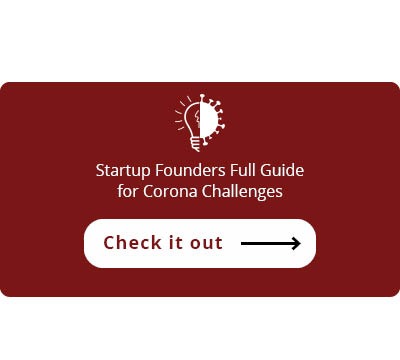The One Skill Founders Forget About That Can Make or Break You!!
23.01.2019

If you are developing a start-up there is one skill that will help you reach your potential faster - the ability to sell!!
It’s a skill that comes more naturally to some people than others, but like any skill it can be developed.
WHY DO YOU NEED IT?
When the time comes to build your team and attract your first partner you need to be able to sell your vision. You need to be able to capture people’s imaginations and convince them that the solution you’ve created and the company you plan to build will succeed. Once you achieve this, you need to be able to convince people to try your product - whether that involves downloading your app, signing a contract or partaking in a free trial; the skill is the same. You need to understand the art of persuasion and succinctly explain what your product does and why people need it.
You must be able to sell.
Once this is done then the hardest selling of all starts - selling to investors and raising capital. In order to do this, you need to be able to tell a story, overcome objectives and close a deal. Most vital of all - you must be able to sell yourself.
So often when VC firms explain why they made an investment into a seed or A-round, it was because they bought into the founders themselves above and beyond the business or its product. It’s impossible to calculate the number of start-ups that never make it because the founders couldn’t sell, but it’s likely to be a frighteningly high number. This is unfortunate because it’s likely that some game-changing, world beating billion-dollar companies never see the light of day because the founders couldn’t clearly & concisely articulate their vision.
In the high-tech scene that is modern Israel storytelling isn’t something people think much about. But every single successful business on the planet starts with a story. Maybe it’s a business plan that runs to 300 pages, a PPT of 25 slides, or an elevator pitch of three sentences. The medium doesn’t matter - it’s the story that counts. Regardless of how sophisticated and technological we become – stories are how humans communicate.
When it comes to getting people (employees, investors, customers, partners) in place to help you build your billion-dollar idea then you have to sell - and the art of persuasion and the words you use count for everything. You have to learn to tell your story. Not a story that merely explains, but a story that literally moves people. A story that enlightens, surprises, angers, convinces, deters, coerces, frightens, amuses and yes, most of all, excites people!! Excites them enough that they stop what they’re doing and do what you need them to do.
Regardless of how clinical and dispassionate your audience may seem, they’re still people. So, it’s important to remember that a story without substance isn’t going to succeed. People act on emotion and justify with logic. This includes the guy from 8200 who graduated from computer engineering you’re trying to recruit, the MIT analysts and the Harvard Business School educated venture capitalist that is contemplating a VC round in your idea.
So, our charts and graphs, financial projections, UX design, and market analysis matter but they are not the story. They are just the supporting act.
Some helpful hints.
What are some actionable insights to help you avoid the missteps that founders often make when it comes to selling?
1. Not selling the problem. Nobody is interested in your solution until they understand the problem. So, focus on that first. What problem am I solving?
2. Not selling the solution. Too often founders enthusiasm for how their product works and the features it has drowns out the more critical point of why they exist in the first place. This results in pitches that are too long and too detailed. There is room for details and technical specificity, but only once the audience is ready.
3. An over dependence on the sales presentation. A deck of slides or a product demonstration can be helpful, but they are not the main character. You are. They are there to support you and help validate your story. They depend on you, but you must not depend on them.
4. Not asking questions. The only way to ensure your story is reaching your audience is to keep checking in with them. This way you can modulate it to suit them. This might mean you have to drill down into more detail, or dumb things down or speed things up or respond to objections or uncertainty. Asking smart questions is the fastest way to earn trust and remain relevant at all times.
5. Not having a clear objective. Each time you talk about your idea you need to have a clear outcome in mind. Every interaction needs to have a clear outcome. It could be that you ask for a commitment, or a further escalated meeting or an agreement to share more information. In any case it’s unprofessional to just let things hang. Always have an outcome in mind - make it clear and make it happen.
Most important of all:
6. Figure out how to pitch your idea in three sentences and learn it off by heart!! This positioning statement will be your saviour when you meet Sir Richard Branson or Warren Buffett in an elevator. It will help your family, friends, staff, investors, customers and the world understand and remember what you do. The three sentences need to encapsulate what you do, who you do it for and why you exist. It sounds easy but it’s actually pretty hard to do. All real entrepreneurs can do this.
The bottom line is this. If you can’t deliver your vision in three sentences, then either you can’t sell, or you don’t have a vision… either way you’re in trouble.
Glenn Riseley is a Melbourne based investor and entrepreneur with a track record of building a portfolio of successful enterprises, spanning advertising, software, aviation and healthcare. The consistent thread across each of them is an almost fanatical enthusiasm for the pitching/selling function. His career commenced at 20 years of age, when he was given a desk and a phone book and told to “ nd some clients”. He learned the art of identifying prospects, opening dialogue, building relationships and closing deals. This has served him well in a career that then took him to sportswear giant Puma, where he quickly rose through the ranks of sales and marketing before moving into advertising and establishing one of Australia’s fastest growing, creative advertising agencies. As well as selling products, Glenn’s skills were honed on selling ideas and within a few short years, his advertising agency listed some of the world’s most respected brands as its clients. During this time Glenn conceived the Global Corporate Challenge, a health software program that he sold into corporations in order to improve the health and engagement of employees.
He has lived and worked selling across the world while being based in NYC and focusing exclusively on the US for 2 years. He established sales and marketing of ces in Singapore, Melbourne, Sydney, London, Zurich, Toronto, San Francisco, Chicago, Dallas, Houston, Sao Paulo as well as generating over $100,000,000 of sales.
www.rialtogrowthpartners.com
It’s a skill that comes more naturally to some people than others, but like any skill it can be developed.
WHY DO YOU NEED IT?
When the time comes to build your team and attract your first partner you need to be able to sell your vision. You need to be able to capture people’s imaginations and convince them that the solution you’ve created and the company you plan to build will succeed. Once you achieve this, you need to be able to convince people to try your product - whether that involves downloading your app, signing a contract or partaking in a free trial; the skill is the same. You need to understand the art of persuasion and succinctly explain what your product does and why people need it.
You must be able to sell.
Once this is done then the hardest selling of all starts - selling to investors and raising capital. In order to do this, you need to be able to tell a story, overcome objectives and close a deal. Most vital of all - you must be able to sell yourself.
So often when VC firms explain why they made an investment into a seed or A-round, it was because they bought into the founders themselves above and beyond the business or its product. It’s impossible to calculate the number of start-ups that never make it because the founders couldn’t sell, but it’s likely to be a frighteningly high number. This is unfortunate because it’s likely that some game-changing, world beating billion-dollar companies never see the light of day because the founders couldn’t clearly & concisely articulate their vision.
In the high-tech scene that is modern Israel storytelling isn’t something people think much about. But every single successful business on the planet starts with a story. Maybe it’s a business plan that runs to 300 pages, a PPT of 25 slides, or an elevator pitch of three sentences. The medium doesn’t matter - it’s the story that counts. Regardless of how sophisticated and technological we become – stories are how humans communicate.
When it comes to getting people (employees, investors, customers, partners) in place to help you build your billion-dollar idea then you have to sell - and the art of persuasion and the words you use count for everything. You have to learn to tell your story. Not a story that merely explains, but a story that literally moves people. A story that enlightens, surprises, angers, convinces, deters, coerces, frightens, amuses and yes, most of all, excites people!! Excites them enough that they stop what they’re doing and do what you need them to do.
Regardless of how clinical and dispassionate your audience may seem, they’re still people. So, it’s important to remember that a story without substance isn’t going to succeed. People act on emotion and justify with logic. This includes the guy from 8200 who graduated from computer engineering you’re trying to recruit, the MIT analysts and the Harvard Business School educated venture capitalist that is contemplating a VC round in your idea.
So, our charts and graphs, financial projections, UX design, and market analysis matter but they are not the story. They are just the supporting act.
Some helpful hints.
What are some actionable insights to help you avoid the missteps that founders often make when it comes to selling?
1. Not selling the problem. Nobody is interested in your solution until they understand the problem. So, focus on that first. What problem am I solving?
2. Not selling the solution. Too often founders enthusiasm for how their product works and the features it has drowns out the more critical point of why they exist in the first place. This results in pitches that are too long and too detailed. There is room for details and technical specificity, but only once the audience is ready.
3. An over dependence on the sales presentation. A deck of slides or a product demonstration can be helpful, but they are not the main character. You are. They are there to support you and help validate your story. They depend on you, but you must not depend on them.
4. Not asking questions. The only way to ensure your story is reaching your audience is to keep checking in with them. This way you can modulate it to suit them. This might mean you have to drill down into more detail, or dumb things down or speed things up or respond to objections or uncertainty. Asking smart questions is the fastest way to earn trust and remain relevant at all times.
5. Not having a clear objective. Each time you talk about your idea you need to have a clear outcome in mind. Every interaction needs to have a clear outcome. It could be that you ask for a commitment, or a further escalated meeting or an agreement to share more information. In any case it’s unprofessional to just let things hang. Always have an outcome in mind - make it clear and make it happen.
Most important of all:
6. Figure out how to pitch your idea in three sentences and learn it off by heart!! This positioning statement will be your saviour when you meet Sir Richard Branson or Warren Buffett in an elevator. It will help your family, friends, staff, investors, customers and the world understand and remember what you do. The three sentences need to encapsulate what you do, who you do it for and why you exist. It sounds easy but it’s actually pretty hard to do. All real entrepreneurs can do this.
The bottom line is this. If you can’t deliver your vision in three sentences, then either you can’t sell, or you don’t have a vision… either way you’re in trouble.
Glenn Riseley is a Melbourne based investor and entrepreneur with a track record of building a portfolio of successful enterprises, spanning advertising, software, aviation and healthcare. The consistent thread across each of them is an almost fanatical enthusiasm for the pitching/selling function. His career commenced at 20 years of age, when he was given a desk and a phone book and told to “ nd some clients”. He learned the art of identifying prospects, opening dialogue, building relationships and closing deals. This has served him well in a career that then took him to sportswear giant Puma, where he quickly rose through the ranks of sales and marketing before moving into advertising and establishing one of Australia’s fastest growing, creative advertising agencies. As well as selling products, Glenn’s skills were honed on selling ideas and within a few short years, his advertising agency listed some of the world’s most respected brands as its clients. During this time Glenn conceived the Global Corporate Challenge, a health software program that he sold into corporations in order to improve the health and engagement of employees.
He has lived and worked selling across the world while being based in NYC and focusing exclusively on the US for 2 years. He established sales and marketing of ces in Singapore, Melbourne, Sydney, London, Zurich, Toronto, San Francisco, Chicago, Dallas, Houston, Sao Paulo as well as generating over $100,000,000 of sales.
www.rialtogrowthpartners.com











